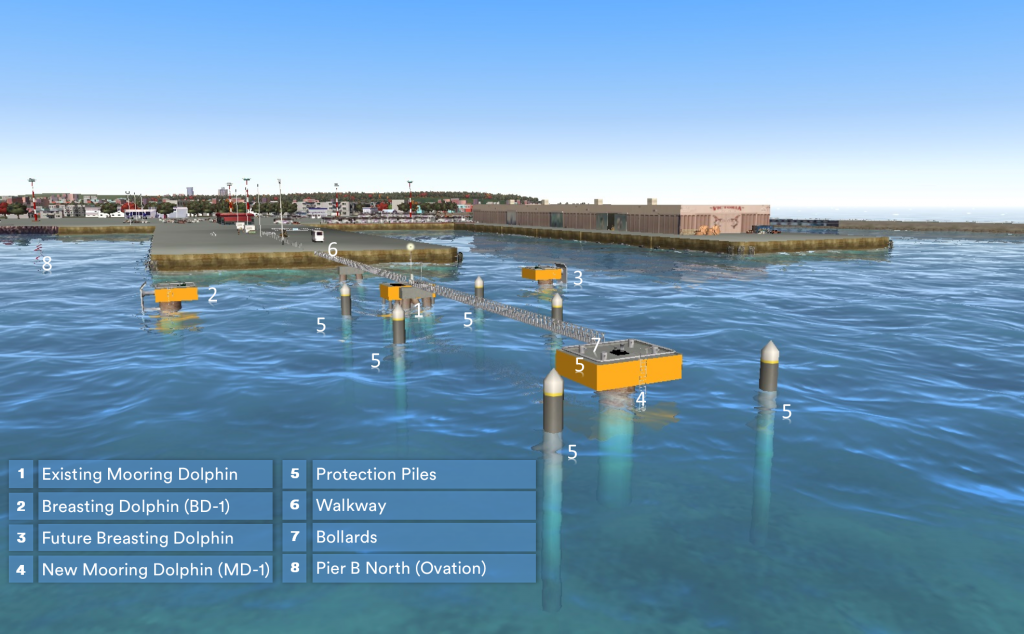Enhancing Capacity at the Victoria Cruise Terminal
The Pier B mooring dolphin extension at the Victoria Cruise Terminal was one of the largest infrastructure projects ever undertaken by the Greater Victoria Harbour Authority. This 58-metre extension was a significant investment in the future of Victoria’s Cruise Terminal, adding the ability to accommodate some of the largest cruise ships in the world.
The extension accommodates cruise vessels up to 350 metres (1,148 feet) in length and approximately 225,000 gross tons. This enhancement supported GVHA’s long-term vision for ensuring Victoria remains a key destination for cruise ships.
Originally scheduled for completion in 2019, the project faced a delay due to the loss at sea of custom-fabricated steel in December 2018. Despite this setback, construction, completed by Ruskin Construction, was finished in just six months, remaining on schedule and within budget.
The project required a skilled team of over 65 professionals, including contractors, suppliers, engineers, and environmental managers. Key components of the structure include:
- Two 3-metre (10-foot) diameter coated steel monopiles with a combined length of 291 metres (954 feet), weighing approximately 96 metric tonnes.
- Two reinforced concrete platforms, requiring 150 cubic metres (196 cubic yards) of concrete, providing a sturdy surface for operations.

GVHA delivered this state-of-the-art infrastructure while maintaining a focus on environmental stewardship and operational excellence. The Pier B mooring dolphin extension supports tourism, economic development, and sustainable marine operations in Victoria.
What is a Mooring Dolphin?
A dolphin is a structure which extends the length of a pier to accommodate longer ships.
Why are Mooring Dolphins installed?
They are installed when it is impractical to extend the pier itself. Cruise ships have become longer in recent years.

Common Questions:
How are the pieces of steel connected?
The steel was connected by welding pieces together. To weld two pieces together, it took approximately 2.41 kilometres (1.5 miles) of weld and 54 passes to complete one weld. It took 3-4 shifts of 12 hours to complete each weld.
Were divers used to work on this project?
Yes, divers installed electrical cables and anodes to the piles.
What is the power and water supply used for this project?
The amount of power and water needed was minimal. Barges have their own power through environmental diesel generators.
How are the piles driven into the seabed?
Piles were driven into the seabed using two interlinked vibratory hammers. These vibratory hammers were joined and synchronized at 56,699kgs (125,000lbs) in weight. They vibrated the pile into the seabed.
How deep does the pile go into the seabed?
The pile is embedded 45 metres (147 feet) into the seabed.
Are the piles left hollow, and will they rust?
90% of the pile is filled with sand, with the top 10% filled with concrete. There is a metalized coating on the outside of the pile to help prevent rust, in addition an anode system is in place to prevent corrosion. Rock was placed around the outside of the pile. The platform that sits on top of the pile, where the ship is tied off too, is concrete as well. We used approximately 126m3 + 29m3 of concrete as well as 3200m3 of rock (3 barges). The concrete was pumped from the pier to the water.
How will the ship connect to the Mooring Dolphin?
There were two parts to this project – the Mooring Dolphin (MD1) and the Breasting Dolphin (BD1). The Mooring Dolphin takes the lead lines from either the bow or stern of a vessel. There are four 400-tonne bollards linked to a large capstan for maximum flexibility. The mooring platform is accessible via a catwalk extension aligned with the existing dolphin constructed in 2014. The Breasting dolphin is equipped with a fender for the vessel to protect from accidental impact and to provide bearing for longer ships as needed. The breasting dolphin is equipped with a 200-tonne bollard and capstan to provide spring line tie up as needed.
Where are the materials for this project from?
Most of the materials were from Canada, including some from Vancouver Island. The steel and fender system were sourced from China. Most staff on this project were from British Columbia.




